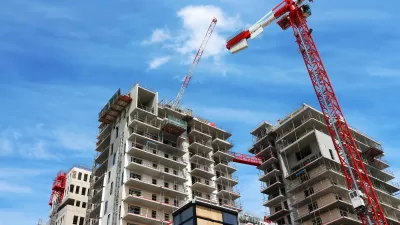It's time to get demand and supply on the same page, according to this report.

The demographics of new households want smaller more affordable houses, but the housing construction industry is building larger homes.
The findings of a new report from real estate advising company RCLCO tell the story, as explained in an article written by Gregg Logan and Rachel Waldman.
Decreasing new home affordability is part of a long-term trend predating the current affordability crisis. The mix of sizes of the new home inventory is driving up home prices in addition to higher mortgage, labor, and land costs. Compared to the years leading up the Great Recession, the share of newly constructed homes larger than 3,000 square feet increased from 19% to 30%.
But here's the big takeaway for planners and other policy makers tasked with envisioning the future and implementing that vision:
There is a larger market for medium-density attached and smaller detached new homes than is currently being offered, and these and other creative solutions will become increasingly important as the U.S. population further diversifies. Otherwise, the size of the overall new for-sale housing market could decline.
A report published by the National Association of Homebuilders earlier this year gives some indication that homebuilders are starting to get the message and building smaller homes.
FULL STORY: Disruptive Demographics: Housing Production & Demographic Reality Are Moving in Different Directions

Maui's Vacation Rental Debate Turns Ugly
Verbal attacks, misinformation campaigns and fistfights plague a high-stakes debate to convert thousands of vacation rentals into long-term housing.

Planetizen Federal Action Tracker
A weekly monitor of how Trump’s orders and actions are impacting planners and planning in America.

Chicago’s Ghost Rails
Just beneath the surface of the modern city lie the remnants of its expansive early 20th-century streetcar system.

Bend, Oregon Zoning Reforms Prioritize Small-Scale Housing
The city altered its zoning code to allow multi-family housing and eliminated parking mandates citywide.

Amtrak Cutting Jobs, Funding to High-Speed Rail
The agency plans to cut 10 percent of its workforce and has confirmed it will not fund new high-speed rail projects.

LA Denies Basic Services to Unhoused Residents
The city has repeatedly failed to respond to requests for trash pickup at encampment sites, and eliminated a program that provided mobile showers and toilets.
Urban Design for Planners 1: Software Tools
This six-course series explores essential urban design concepts using open source software and equips planners with the tools they need to participate fully in the urban design process.
Planning for Universal Design
Learn the tools for implementing Universal Design in planning regulations.
planning NEXT
Appalachian Highlands Housing Partners
Mpact (founded as Rail~Volution)
City of Camden Redevelopment Agency
City of Astoria
City of Portland
City of Laramie





























